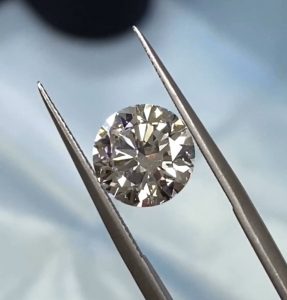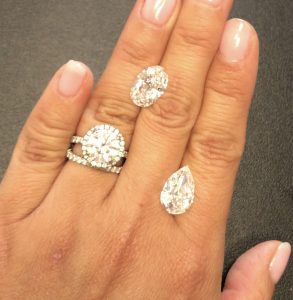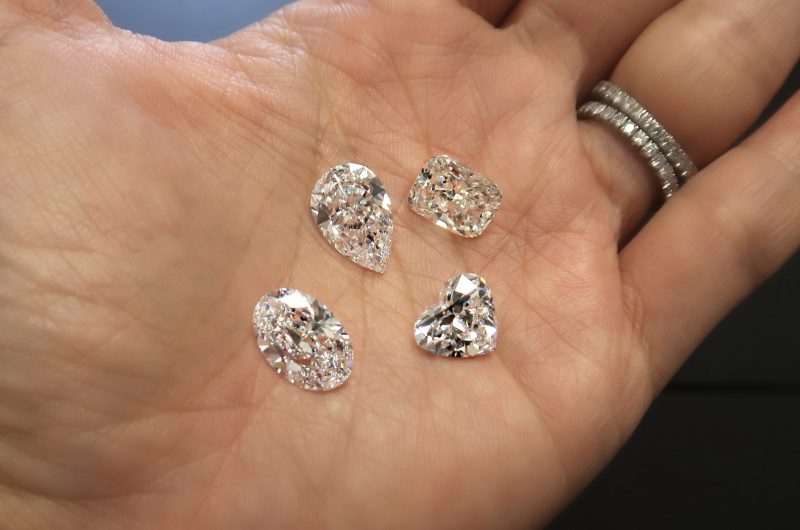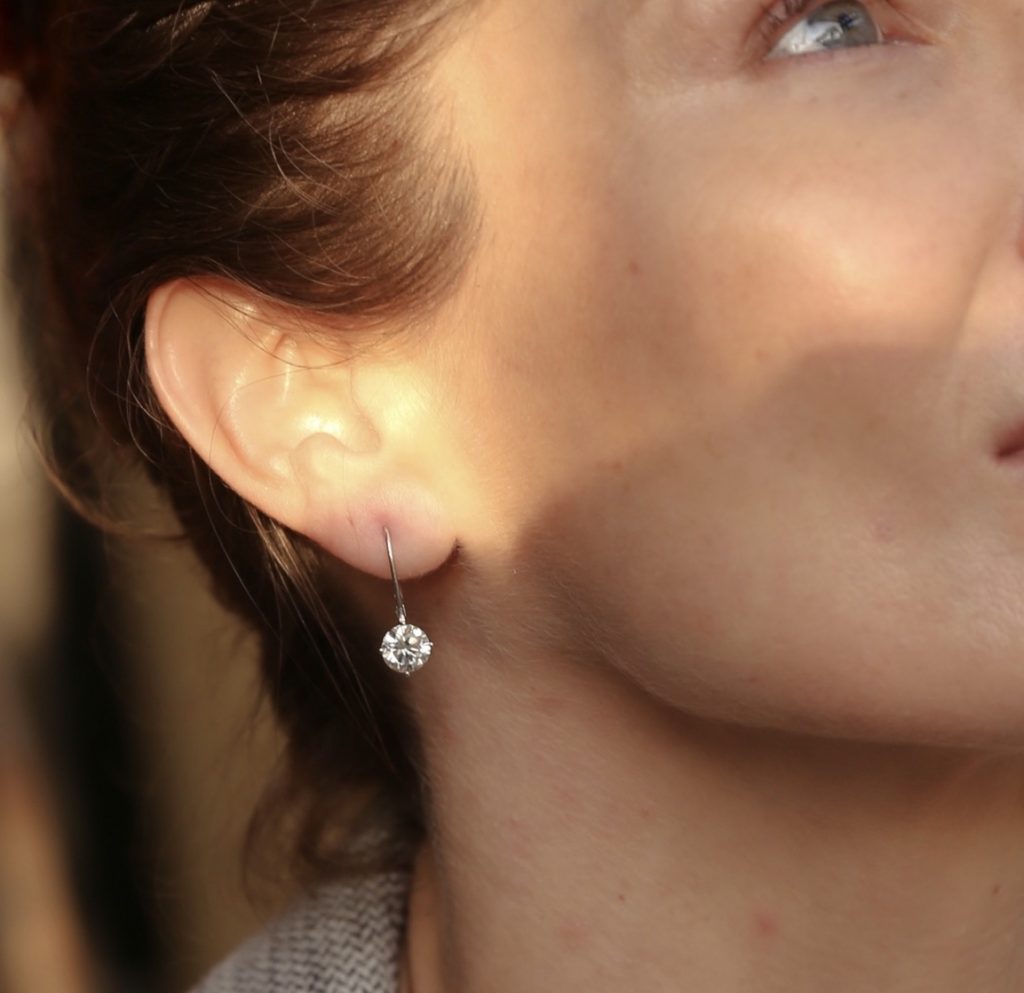With COVID-19’s affect on the world and our economy, we are all trying to figure out how to adjust our lives to the new normal. It is still unclear what that will look like, but many people are forced to cut back on spending until things become more stable.
Pandemic’s Impact on Diamonds
I’ve been thinking about the pandemic’s affect on the diamond industry. As an independent, private fine jeweler whose focus is on the interests of my customers (not the jewelry industry), I want to educate you on the alternatives to natural earth diamonds in case it is an alternative you’re thinking about.
Earth grown diamonds are still my #1 preference, especially for an engagement ring. But not everyone can afford the high cost of a natural diamond.

Best Alternatives to Diamonds
This post discusses my opinion on the best alternatives to natural diamonds for 1 carat or higher stones.
The list below shows my preference of Earth Grown Diamond substitutes. I have just 2.
- Moissanite
- Lab grown diamonds
I’ll go into detail on these two alternatives in a bit. But first, let’s visit the magic of earth grown diamonds.
Diamonds are known for their brilliance. They play with light like no other gemstone, resulting in a sparkle that can’t be matched. Diamonds have high reflective properties that allow them to sparkle even when their surfaces get dirtied over time.
Diamonds are the strongest natural stone in the world. They are durable enough for rough exposure and daily wear. Only a diamond can scratch another diamond.
There is something very special about a stone that starts out as a piece of carbon 100 miles deep in the Earth that forms into the world’s most durable, most sparkly stones and travels close enough to the earth’s surface to be extracted. I may be “old school,” but an earth grown diamond is much more romantic to me than one that is identical but created in a lab.
However, as prices continue to decrease with the evolution of lab grown diamonds, my opinion could change! It is all based on our cost/benefit.
Diamond Alternatives Based on Price
Given this, based on curiosity, let’s now talk about the substitutes for earth grown diamonds based on price.
- Lab grown diamonds
- Moissanite
- White Sapphire
- White Topaz
- Cubic Zirconia

oval and pear natural earth diamonds
Lab Grown Diamonds
Lab grown diamonds are virtually identical to natural diamonds. Synthetic diamonds have similar chemical and molecular components to real, natural diamonds. Although they are better in quality than moissanite (it is easier to tell a moissanite is not an earth grown diamond) I believe their price is still relatively high. A lab grown diamond for larger than 1 carat is still only about 30-40% lower in price than an earth grown diamond. Personally, this discount is not enough for me to choose a lab grown diamond over an earth grown. As of now, I think the main reason one should get a lab grown over earth grown diamonds is if they are against mining practices.
Key notes about Lab grown diamonds:
- Lab grown diamonds come in the same sizes, shapes, cuts, and colors as natural diamonds.
- They possess the same brilliance, sparkle, and clarity.
- The only differences between lab grown and natural diamonds lie in the unique fluorescence of lab grown stones and in the absence of nitrogen in lab grown stones. These factors don’t effect their outside appearance.
- Lab grown diamonds are ethical and sustainable gemstones with traceable origins.
- How to Recognize Synthetic Diamonds:The stones need expensive, specialized equipment to tell that it is lab grown.
- Even when it’s unclear to the naked eye how a synthetic diamond differs from a natural diamond, it is crucial for resale and insurance values.
Moissanite
The key differences between Natural or Lab grown diamonds and synthetic Moissanite is Moissanite’s rainbow effect in sunlight. Although natural earth grown moissanite does exist, it is extremely rare. When you see sales of moissanite stones, you can assume they are synthetic.
- Moissanite is excellent for daily wear and exposure and are easy to maintain. At a 9.25/10 Mohs hardness, Moissanite is hard enough to be used in any type of jewelry.
- Moissanite has a more colored fire/sparkle than lab grown and natural diamonds which is one of the few naked eye ways to distinguish it from them. Under sunlight, moissanite stones tend to exhibit a fiery and colorful sparkle, sometimes called the ‘disco ball’ effect. This is especially clear in large moissanite stones.
- For Moissanite, the size and the overall quality grade (either Premium or Super Premium) are taken into consideration to assess price.
- Moissanite are ethical and sustainable gemstones with traceable origins. This makes them good options for someone concerned about where their gemstone comes from.
Moissanite is much less expensive than Lab Grown diamonds. For example, a round cut Moissanite stone similar in size to a 2-carat round cut diamond is only ~$2,000. Compared to a natural diamond 2 carat round stone at around $20k and a lab grown diamond at $12,000.
How to Recognize Moissanite – Hold the stone in sunlight. If it shows rainbow colors, it is likely a moissanite.
White Sapphire
White sapphires are generally duller than diamonds and can even appear milky or cloudy. White sapphires exhibit less sparkle. The beauty of the sapphire is in its whiteness, not the sparkle.
One of the main shortcomings of white sapphire and the reason I don’t recommend it in place of a diamond, is the need for regular cleaning. When the gemstone gets dirty, its sparkle is dimmed.
Sapphires are strong but more prone to scratching than a diamond. White sapphires are much more affordable than diamonds at $200-$300 per carat. But if you’re looking for the look of a white diamond, I recommend one of the choices above.
How to recognize White Sapphire : White sapphires are often posed as diamonds but don’t offer the diamond’s signature sparkle. If the stone seems more blurred in coloring, it is likely to be a white sapphire.
White Topaz
Unlike cubic zirconia, which is synthetic, white topaz is natural. White topaz ranges from about $50 to $100 per carat. Topaz is formed from granite rocks that contain more minerals than your average vitamin. In the purest form, topazes are naturally white or clear. Most, however, are tinged with color.
Since white topaz is a natural gemstone, it can have some internal imperfections that developed during its formation. Some stones may have easily visible inclusions, while others may look flawless to the naked eye.
Compared with other gems, this stone is relatively clean and tends to have a glassy appearance. White topaz is easy to scratch or break, and its color is affected by high temperatures.
While a white topaz may look like a diamond at first glance, you can look closely at a white topaz using magnification to see if there are any scratches on the surface. Diamonds will not have scratches because of their durable composition.
Cubic Zirconia
Cubic zirconia is made of zirconium dioxide. It is produced synthetically and does not come close to diamond in terms of durability. Cubic zirconia is inexpensive but loses its brilliance quickly. Cubic zirconia tends to have more fire than white topaz.
A cubic zirconia is one of the easier fake diamonds to test for authenticity. By using the sparkle test, for example, it’s relatively easily gauge the amount of sparkle and fire a stone is giving off. In addition, cubic zirconias reflect orange tinted light. They also weigh more than a real diamond and generally don’t have imperfections or inclusions. In my opinion, it’s better not to wear anything at all than a cubic zirconia. There are different grades of cubic zirconias, but it is easy to tell the stone is not a real diamond.
Key Takeaways
My recommendation in a nutshell
- Buy natural diamonds from the earth.
- If you can’t afford a natural diamond but love the look of a 2 carat, think about investing in a nice setting with real diamonds and using a moissanite for the center stone and replace it later with a natural diamond.
- Invest in a lab grown diamond if sustainable, environmentally friendly practices are most important to you.
- White sapphires are too pricey for its lack of sparkle to pose as diamonds.
- If you are looking for a lower priced option for smaller stones with the look of a diamond, use Moissanite if you want sparkly, use topaz if you are looking for rose cut looks. Topaz will look more glassy.
- I do not recommend cubic zirconia in any instance. The stone loses its sparkle quickly and in my opinion, it’s very easy to tell a cubic zirconia is not a diamond.
It’s a tough time in the world, but celebrations of love and special occasions should not be dismissed.
If you are looking for an engagement ring or a special piece, I’d love to help you design the fine jewelry of your dreams.
I offer complimentary zoom consultations to get started. Contact me to explore your options!
For other articles about Fine Jewelry, visit my Jewelry blog section.
Stay well, Stay happy. And let’s continue to celebrate life!






